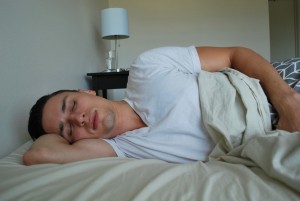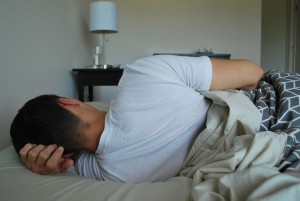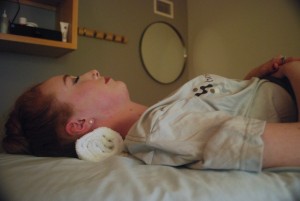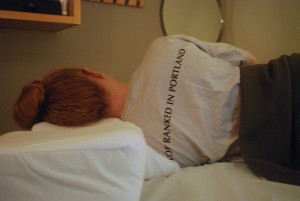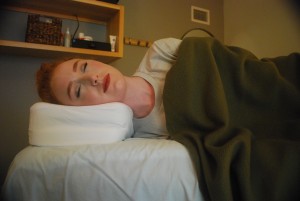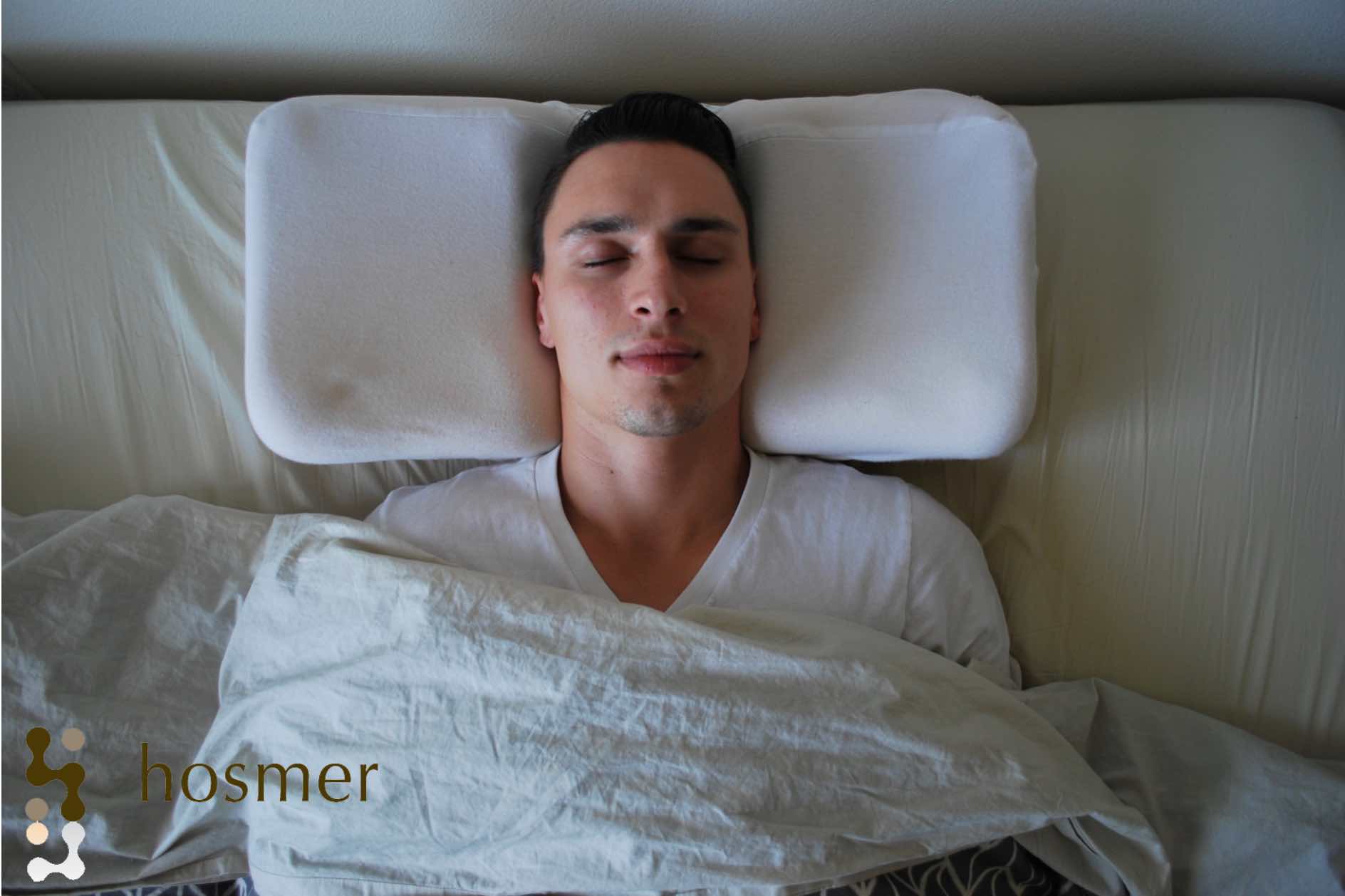
Do you often find yourself waking up with neck or back pain and stiffness? Do you toss and turn at night, smashing, poking, flipping and prodding your pillow…trying to return to the level of comfort that allows you to drift back to that evasive slumber? If you have ever woken up with a sore, stiff, or painful neck, shoulder, or back, you may be feeling the wrath of an improper sleep. Have you ever thought that the large lump of fluff you call a pillow might be contributing to your sleeping frustrations?
After all, you weren’t born with a pillow under your head and for the first years of your life you slept soundly without one. You lay there swaddled in your crib asleep on your back, on a cushy surface for sure, but without the propped up, forward or laterally flexed neck position that a pillow often forces you into.
As human adults, however, we are unique in our supposed need to sleep with props. No other animals on our beautiful Earth requires anything but a safe, predator-free location, to allow themselves to drift into the most vulnerable point in their day. Undoubtably, our earliest ancestors didn’t require much in the way of sleeping utensils either. It is well known that humans share nearly 99% of their DNA with Chimpanzees, and yet the chimp is content to sleep on its side with a single, or double arm, under their head, or on their back with their head flat on the ground.
I know what you’re thinking. In a world where being healthy and staying physically fit seems to mean becoming primal, eating like a caveman; running barefoot on trails in the woods; and now here I am telling you to go minimalist with your most coveted rest period and sleep without a pillow.
Before you navigate away from this post, or vigorously shut your laptop while letting loose a cry of primal frustration, let’s explore the idea of the pillowless sleep a bit further. First, let’s look at a brief history of the pillow.
The first use of pillows supposedly occurred roughly 9,000 years ago in ancient Mesopotamia (modern day Iraq), and Egypt. These original pillows were made of stone or wood and were not originally designed for comfort, or support, but instead were meant to significantly elevate the head. This extreme elevation of the head was meant to keep insects from crawling into the ears, or mouth, while also protecting the elaborate hairstyles of the upper class. These hand carved chunks of stone did not come cheap, and so during this time, only the wealthy used pillows. Because of this, the number of pillows an individual had became a symbol of their status. The more pillows one owned, the more affluent the individual was.
It is not until sometime later that the peoples of ancient Europe brought about the emergence of softer headrests. The ancient Greek and Roman cultures began to master the creation of the softer pillow. These pillows began to resemble the craftsmanship of a pillow that we might recognize today. But, once again these pillows were only attainable by the wealthiest of people, were often very decorative, and more a symbol of wealth than a necessity. It wasn’t until the industrial revolution that the mass marketing of fine goods was made readably available to the general public.
Now, in the modern world we tend to think of the pillow as a necessity of our slumber. As stated earlier in this post, that is not the case. But, does that mean our fluffy friend has no place in our sleeping habits?
The thought process behind our modern pillow is undoubtably intended to aid us in our sleep, no matter where it evolved from. However, the majority of individuals are searching for that support in fluffy, thick, overly large pillows, that have been created to mimic the pillows that evolved from wealth and style and not with a conscious effort to work with our anatomy to cradle our head and neck in a neutral position. The thick pillow isn’t so bad if you are a side sleeper, (remember that just like chimpanzees, early humans undoubtably used their own arms to support their head when sleeping on their side) but if you sleep on your back or your front, then a thick fluffy pillow is basically the antagonist of restful sleep and a healthy spine. This is due to these “monstrosities of fluff” pushing our head into various positions of flexion and extension, basically breaking the healthy neutral position that our head should be in to keep our neck muscles relaxed and happy.
In an earlier post by Dr. Seth Hosmer, “Is Your Sleep Position Harming Your Health,” the pros and cons of each sleeping position were outlined, and strategic ways to use (or not use) your pillows were presented. The general consensus is that the best position to sleep in is on your back with a your head held in a neutral position.
In this position, a small amount of support at the neck is acceptable to help keep the natural curve of the cervical spine, with a minimal amount of cushioned support for the skull. Or, if you have a healthy neck and is not too drastic of a change for you, just avoid a pillow altogether in this position. Remember, in this sleeping position the plane of the face should be running horizontal or parallel to the ceiling. Here is where our standard pillow fails in its role as a sleep aide. It is generally too large and thick to properly cradle the head and neck without causing major forward bending at the cervical spine.
The second best position is on our side. In this position the pillow should be the thickness of your shoulder with enough firmness from your pillow to support the head and neck strongly in a neutral position, but with enough cushion that your arm isn’t a preferable option. In this sleeping position, your head should be neutral. You may find that your pillow is too large or too small to accommodate a completely neutral head and neck position.
After replacing your pillow with a more accurately sized one, you can recycle your old fluffy pillow by placing it between your legs in order to keep your hips and thighs in a neutral position similar to what they would be if you were standing up.
As stated in Dr. Hosmer’s post, if you sleep on your stomach, then you should be actively working on sleeping on your side or on your back. Nearly any pillow in this position forces your head to be placed in intensely rotated positions, and pushes your spine into unnatural, potentially detrimental curvatures.
If you are a back sleeper who after reading this post, pulled your fluffy hunk of a pillow out from under your head and attempted to lower your head and neck to the bed behind you, only to find that there appears to be an infinite distance between your head and your bedding, then your neck is probably in need of some retraining. Our suggestion is to slowly and incrementally lower your head over the course of several months to a year.
Try changing the height an inch at a time, making no immediate drastic changes, until your neck sits comfortably in a neutral position. Going through a cervical stretch series might also be a good option for you. You can find the directions for doing that safely in our video section (video number 12).
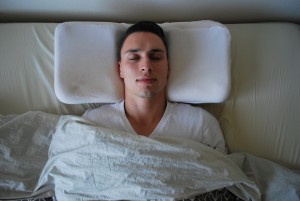
Get sized for a Therapeutica Pillow at our clinic
If you find the idea of tossing your pillow a tough one to comprehend; you’re feeling like your head isn’t stable when you’re sleeping without a pillow; you’re wanting to try the neck roll idea; or you need to find a properly sized pillow for side sleeping; then we recommend coming in and getting sized for the Therapeutica Sleeping Pillow. The important attribute of these pillows is the fact that they are properly and individually sized to your own neck to shoulder ratio. This ratio is different for everybody and is crucial for maintaining a neutral spine while laying on your sides or on your back. They wouldn’t have won any fashion awards in ancient Egypt or Greece, but they will certainly help you to have a restful sleep and help to keep your neck and back feeling like they were meant to feel after a good nights sleep.
